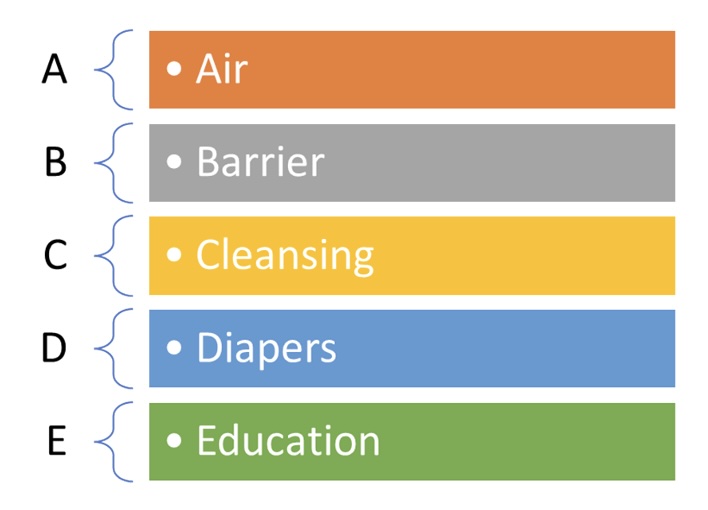Diaper Rashes in Babies: What Parents must know?
Share

Understanding and Managing Diaper Rash
Diaper rash is a common skin issue in babies aged 1 to 24 months, causing redness, itching, and discomfort.1-3 while most cases are mild and heal within a few days, they can be distressing for both babies and parents.4-5 Fortunately, diaper rash can often be prevented and treated at home with proper care. This guide explains its causes, symptoms, treatments, and prevention methods.
Causes of Diaper Rash
Several factors contribute to diaper rash, including:
- Prolonged Moisture Exposure: Keeping a baby’s skin in contact with urine and feces for too long creates a damp environment that irritates the skin. A higher pH level can worsen the irritation by converting urine into ammonia
- Friction and Rubbing: Diapers that fit too tightly can cause chafing, making the skin more prone to rashes.
- Sensitivity to Products: Some babies react to the chemicals in baby wipes, diapers, lotions, or barrier creams.7
- Infections: Bacteria (such as Staphylococci & Streptococci) and fungi (such as Candida) thrive in warm, moist conditions, increasing the risk of infection in the diaper area.1,5
- Dietary Changes: Introducing new foods (or complementary feeding) can alter stool consistency and frequency, potentially triggering a rash. Breastfed babies may react to certain foods, low in Zinc, (e.g. white rice, cherry, bananas, broccoli, sugary foods s.a candies & cookies) in their mother's diet.3,8
- Infrequent Diaper Changes: Keeping a soiled diaper on for too long increases irritation and infection risk. Newborns typically need a diaper change every 2 to 3 hours, while babies, more than 2 months need a diaper change every 3 to 4 hours
Symptoms of Diaper Rash
Diaper rash usually affects the thighs, buttocks, genitals, and lower abdomen.3,5,6 Common signs include:
- Redness and inflammation
- Painful bumps or blisters
- Skin irritation
- A shiny, irritated appearance
- Severe cases may include pus or discharge
- Fussiness and discomfort in babies
Prevention: The ABCDE Approach

You can prevent most diaper rashes by following these simple steps3,7:
A - Air Exposure Allowing your baby’s skin to breathe reduces friction and irritation. Recommended diaper-free time:
- 0-3 months: 5-10 minutes, 2-3 times a day
- 4-6 months: 10-15 minutes, 3-4 times a day
- 7-12 months: 15-30 minutes, 2-3 times a day Ensure diaper-free time is in a warm room to keep your baby comfortable, especially in winter.
B - Barrier Protection Applying a protective barrier cream helps shield the skin from moisture. Natural ingredients like coconut oil, beeswax, and cow ghee are especially helpful. Better to avoid baby powders containing talc.
C - Cleansing Gently clean the diaper area using lukewarm water and a soft cloth or 99.9% water-based baby wipes. Harsh soaps and wipes with fragrances or preservatives can increase irritation.6,7
D - Diaper Hygiene Change diapers frequently to keep the skin dry. Recommended diaper-changing frequency3,5,7:
- Newborns: Every 2 hours (10-12 times a day)
- Babies, 2 to 6 months : Every 3-4 hours (8-10 times a day)
- Babies, 6 months & older: Every 3-4 hours (5-6 times a day)
(Always change diapers immediately after bowel movements).
E - Education on Proper Care Learn the best practices for diaper hygiene:
- Wash hands before and after each diaper change.
- Wipe from front to back to prevent infections.
- Avoid scrubbing the baby skin harshly.
- Use fragrance-free, alcohol-free & paraben free products/wipes.
- Keep the diaper snug but not too tight.
When to See a Doctor
If the rash does not improve within a few days despite proper care, or if symptoms worsen with severe redness, blisters, or pus, consult a pediatrician.
Dos and Don’ts of Diapering
Dos
- Change diapers frequently.
- Keep the diaper area clean and dry.
- Allow diaper-free time daily.
- Use a barrier cream for protection.
- Follow proper diaper hygiene.
Don’ts
- Do not rub or scrub the affected area.
- Do not ignore persistent diaper rash.
- Do not overtighten diapers.
- Do not use scented or alcohol-based products.
- Do not put tight-fitting pants over diapers.
Additional Tips for Prevention & Treatment
- Keep your baby’s skin dry and clean.
- Use hypoallergenic, odorless products preferably
- Apply cool compresses to soothe irritated skin.
Conclusion
Diaper rash is a common but manageable issue. By understanding its causes and following preventive steps, parents can help keep their baby’s skin healthy. If you have any concerns, consult a pediatrician or reach out to our customer care team at 1800 2027 760 for further guidance.